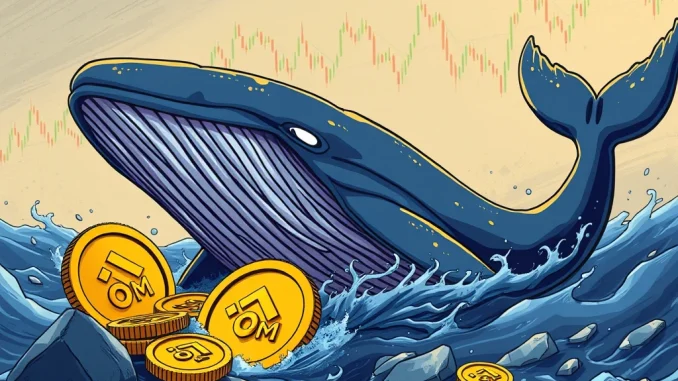
Tracking the movements of large cryptocurrency holders, often referred to as ‘whales,’ provides fascinating insights into market dynamics. A recent notable transaction involving the OM token has captured the attention of the crypto community, revealing a significant move by a prominent whale address.
What Happened with the OM Token Whale?
According to data shared by Onchain Lens on X, a specific whale address, identified as starting with 0xb125, recently made a substantial deposit to the Binance exchange. Here are the key details:
- Asset: OM token (Mantra)
- Amount Deposited: 10.42 million OM tokens
- Value at Time of Deposit: Approximately $2.17 million
- Destination: Binance exchange
- Timing: The deposit occurred approximately five hours ago from the time of reporting.
This large Binance deposit is particularly interesting when viewed in the context of the whale’s historical activity with the OM token.
Analyzing the Whale’s Previous OM Token Activity
Further analysis of the whale address 0xb125’s on-chain history reveals their prior significant accumulation of OM tokens. The whale reportedly purchased a total of 27.92 million OM tokens. These purchases were made from crypto prime broker FalconX over a period spanning from December 12, 2024, to April 14, 2025. The total cost of these acquisitions amounted to a staggering $24.29 million.
Comparing the purchase cost to the value of their holdings (and the recent deposit) paints a clear picture of their current position.
Facing a Significant Crypto Loss
Based on their purchase history and the current market value of the OM token, the whale is estimated to be facing a substantial crypto loss. The reported loss stands at approximately $8.34 million. This figure highlights the volatility inherent in the crypto markets, even for large, sophisticated players.
The decision to deposit a significant portion of their holdings ($2.17 million worth) to an exchange like Binance while sitting on an $8.34 million unrealized loss raises questions about the whale’s strategy and market outlook.
Why Deposit OM Tokens to Binance While at a Loss?
Several potential reasons could explain why a crypto whale might deposit tokens to an exchange, even when facing a significant loss:
- Liquidity Needs: The whale might require capital for other investments, operational costs, or personal reasons, necessitating the sale of assets despite the loss.
- Risk Management: They might believe the price of OM could drop further and are choosing to cut their losses now rather than risk a larger downturn.
- Portfolio Rebalancing: The whale could be shifting capital into other assets they believe have better future prospects.
- Tax Loss Harvesting: In some jurisdictions, selling an asset at a loss can be used to offset capital gains, though this depends heavily on local regulations.
Understanding these potential motivations requires looking beyond just the price chart and utilizing on-chain data to gain deeper context.
The Importance of On-Chain Data
This event underscores the value of on-chain data in the cryptocurrency market. By analyzing public blockchain transactions, platforms like Onchain Lens can track the movements of large holders, exchange flows, and accumulation/distribution patterns. While not predictive on its own, this data provides valuable insights into market sentiment and potential future price action. A large Binance deposit by a whale often signals potential selling pressure, although deposits don’t always result in immediate sales.
What Can We Learn from This Whale’s Move?
This scenario offers a few key takeaways for investors:
- Volatility is Real: Even whales with large resources can incur significant losses in crypto.
- On-Chain Data is Powerful: Tracking whale movements provides valuable context, but should not be the sole basis for investment decisions.
- Losses Happen: Deciding when to cut losses is a critical part of risk management in trading.
- Context is Key: A large deposit doesn’t automatically mean a dump; consider other factors and the whale’s history.
Summary
The recent deposit of $2.17 million worth of OM tokens by a whale to Binance, amidst an estimated $8.34 million crypto loss, highlights the dynamic and often challenging nature of the market. This event, brought to light by on-chain data analysis, serves as a reminder that even the largest players face volatility and difficult decisions. Tracking the activities of a crypto whale provides valuable insights, but it’s crucial for investors to conduct their own research and manage risk effectively rather than blindly following large transactions.



